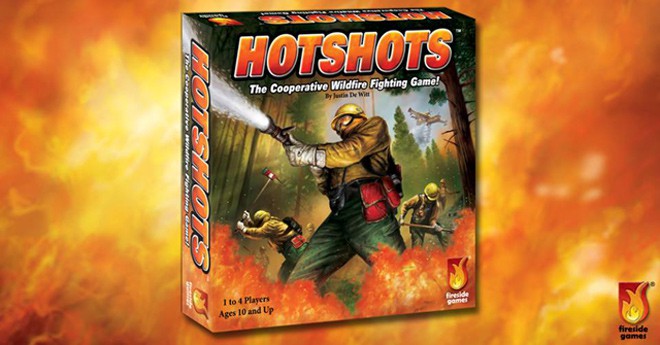Hotshots is a cooperative firefighting game for 1-5 players, designed by Justin DeWitt and published by Fireside games.
What, another firefighting game??? When will the market stop getting flooded with these?
I kid, of course. There are a few other firefighter games out there, but only one of note – Flash Point: Fire Rescue. Both are fairly light, family-style games where players work cooperatively to manage fires, so comparisons are inevitable. As opposed to using action selection to fight building fires, though, Hotshots employs a “push your luck”, dice driven mechanism to fight forest fires.
I don’t think it’s a stretch to say that the gamers who bought and enjoy Flash Point are the very same ones who might buy and enjoy Hotshots. However, Flash Point has a big head start, due to a very good reputation and loads of expansion content. Hotshots has some catching up to in order to carve a space out for itself. Does it have the legs to do so?
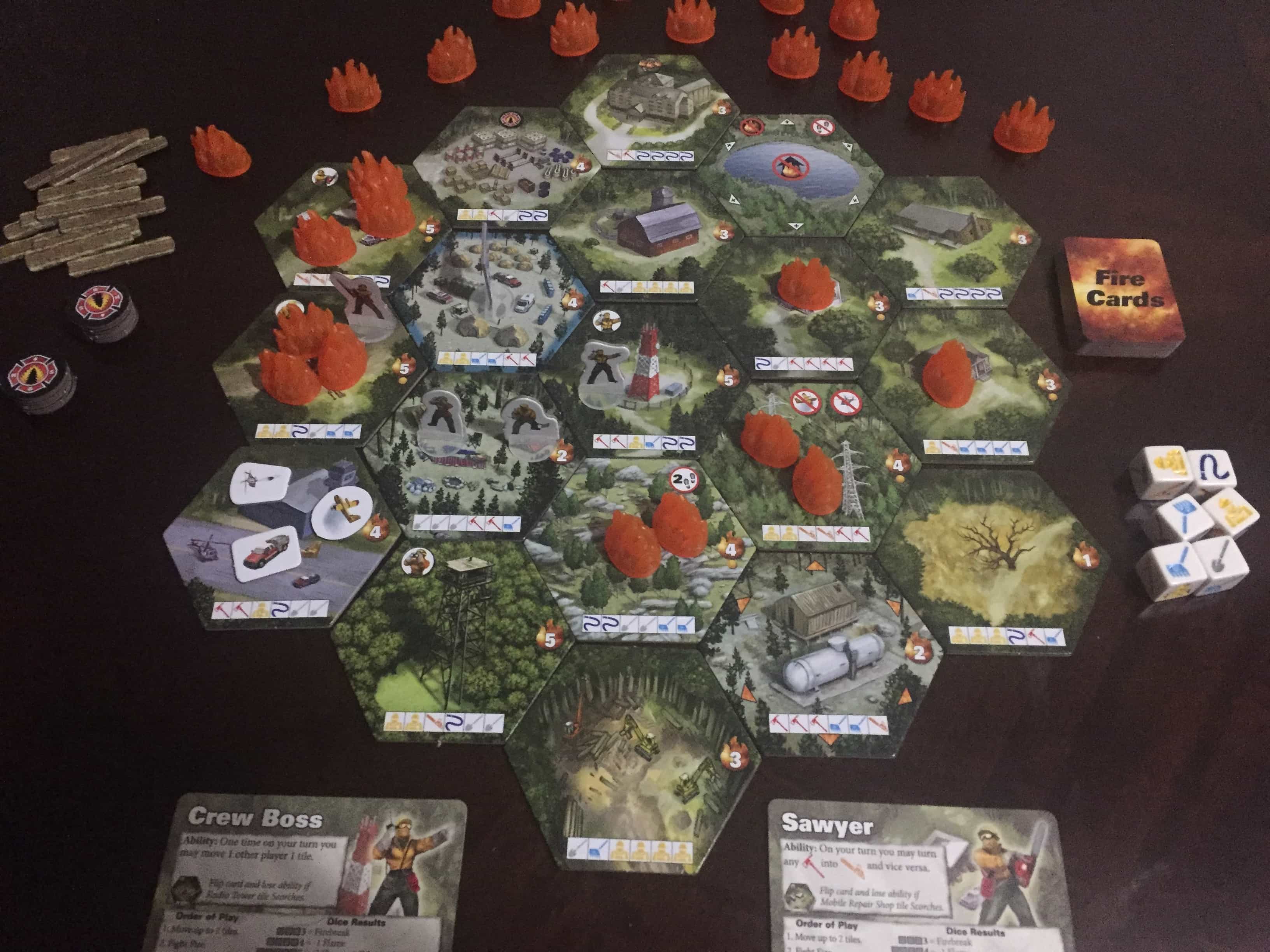
How to play Hotshots
You begin by setting up 19 hex tiles which constitute your forest. You then seed the board with some starting fire, according to setup rules. After that, you select a firefighter (two if you play solo). Each firefighter has a simple special ability that will be useful in almost every turn of the game, so be sure to take note of it. Put all of the other game tokens and dice nearby, and setup is done! Easy, right?
During a typical turn, each firefighter will move their standee up to two spaces and attempt to fight fire in that area. Once you land on a space, you then roll to determine how much fire you will actually fight.
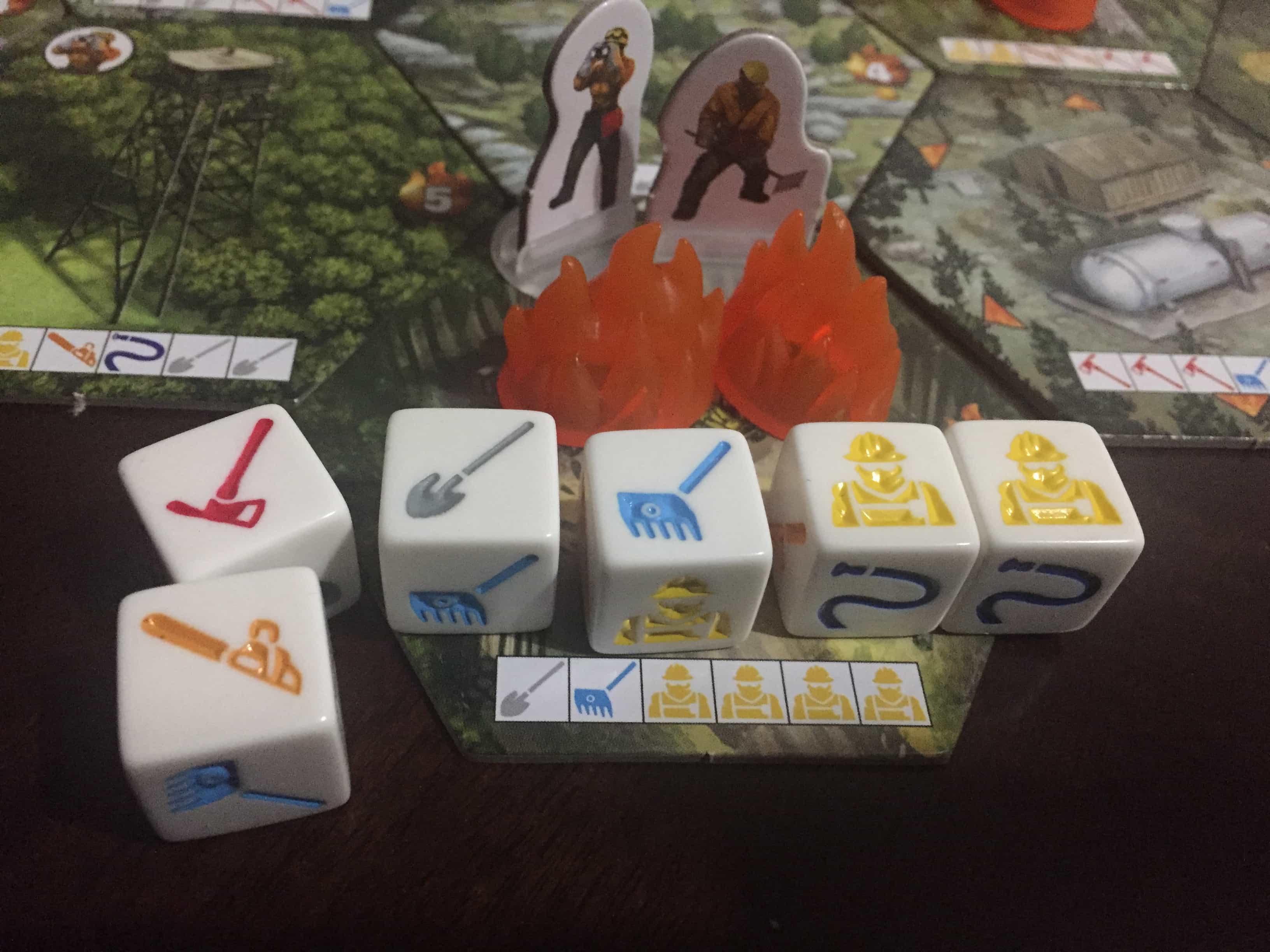
You must match as many symbols as you can to those depicted on the tile. If you are able to match at least one symbol, you can pick up all the dice and re-roll them. If you match at least three fire symbols, good stuff starts to happen! You can remove fire tokens, put up “breaks” which block the fire from spreading, or even gain bonus tokens which provide one-time buffs.
If you fail to match any symbol on a roll, though, you lose your saved dice and… well, just try to avoid doing that too often.
To avoid too much failure, bring a buddy – for every other firefighter in your square, you get one free reroll.
Like any good cooperative game, after you finish your turn, the board fights back! You will pull a card from the event deck which will either grow fire that’s already there, or trigger a gust of wind that spreads fire to neighboring tiles. The game comes with a little flag standee to indicate the direction of the wind, which will change as the event deck progresses.
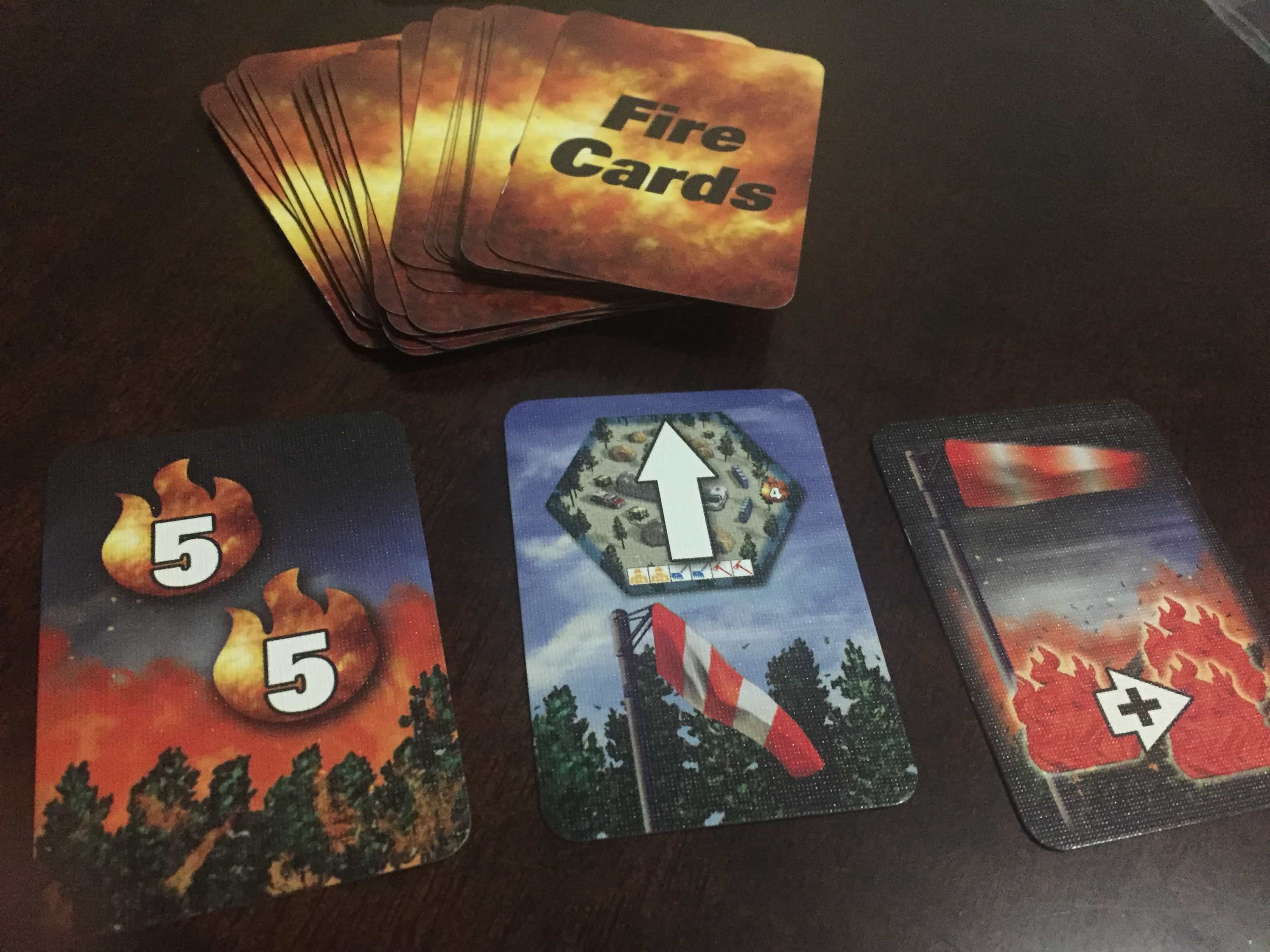
Each tile has a number on its right hand side – the “Scorch limit”. As the board fills up with fire throughout the game, you will take any tiles that reach the Scorch Limit and flip them over to their burned out side. That tile can no longer receive any fire, which is good. However, if you get eight burned out tiles, the game ends in a loss. Also, if your main base burns down, you lose.
As mentioned previously, each firefighter has a special ability which you will probably use on most rounds. In addition, you can launch special vehicles from the Air Attack Base tile which provide powerful but one-and-done benefits, like dumping a bunch of water into one space, or strafing multiple tiles with water.
Both the individual firefighter abilities and the vehicle one-and-done powers are tied to spaces on the board. If they blow up, you no longer have access to the relevant power. I ask you, how can the Crew Boss radio for help if the radio tower burned down?
If you put out all of the fire everywhere, though, you win! Who needs victory points?
What I liked about Hotshots
When I set up Hotshots at my local game store a few nights ago, people were instantly drawn to the little fire tokens. I wouldn’t say this game has amazing components, but that’s probably a good thing since it’s a family game meant to have a low price point. I like the fact that, even though most of the components are middle-of-the-road in quality, at least they managed to work in an aspect (the fire tokens) that added some pop.
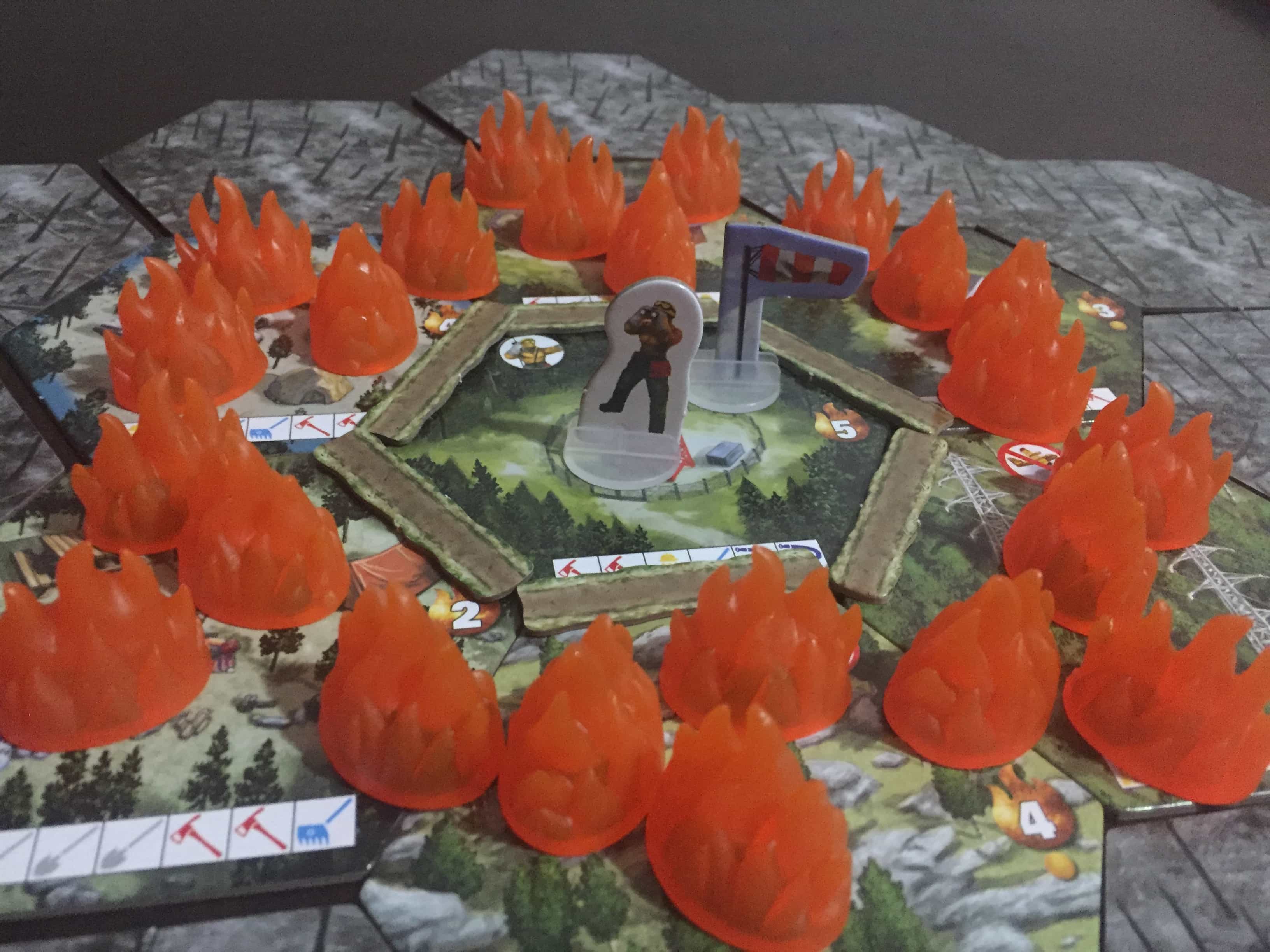
If you want to enjoy this game, you have to be cool with rolling dice LOTS and LOTS of times. With regard to the dice, I felt that the push-your-luck aspect was integrated very well. The odds are greatly in your favor that you will roll three needed symbols, which guarantees at least the minimum amount of success.
The interesting decisions come when you want to go for four or five successes. At that point, you need to calculate odds, use your tokens, plan for support, and weigh the general benefits of success and failure. I found those decision points very tense and satisfying.
You might get really, really hosed and match only two symbols on a turn, even with all the support in the world. However, as horrible as that feels when it happens in the moment, I think the game was designed to handle that and not let it portend automatic doom. I think I had that happen at least once in all of the games I played, and I was still able to recover… some of the time.

So, even though you might look at all of the dice and think “total luckfest”, I found that the basic design of the game, as well as its resources for mitigation, more than countered the risk of losing due to sheer luck. That’s a neat design trick to pull off in a dice-driven game, so kudos to Justin De Witt for that.
Finally, I loved how each of the firefighter powers were tied to spaces on the board. Many times, the group would come to a consensus about a course of action, but then a player would try to convince the group to save their personal power tile instead. That created some great back-and-forth table talk and tactical decision making.
What I didn’t like about Hotshots
To answer the question I posed in my intro, I do think that Hotshots does enough to stand on its own and distinguish itself from Flash Point. However, Flash Point maintains its edge, at least for me, for a few reasons.
In Flash Point, fighting fire is only a secondary goal; you must rescue a certain number of victims from the burning building before it collapses. Every turn in Flash Point, therefore, presents a push and pull between your short term and long term objective – fight the fire that’s raging right next to you, or move to achieve the longer term goal of saving people.
In Hotshots, all of the objectives are short term – fight fire in this tile, or in that tile. In that way, Hotshots resembles the more well known Fireside product, Castle Panic, where your only overall goal was to defend the tower and your choices consisted of which enemy to fight. I like Castle Panic and feel it has rightly earned its popularity. However, I won’t play it without Wizard’s Tower expansion (which added spells and more unique monsters) because I find the base game alone a little flat and repetitive.
I think Hotshots does a bit better job of mixing things up, via the dice, than base Castle Panic. However, I still felt I was doing many of the same things every turn – move and roll, move and roll. The support tokens can help that. However, you only get them if you roll five successes in a turn. I had a friend in one game who didn’t get a single support token. He was sad.
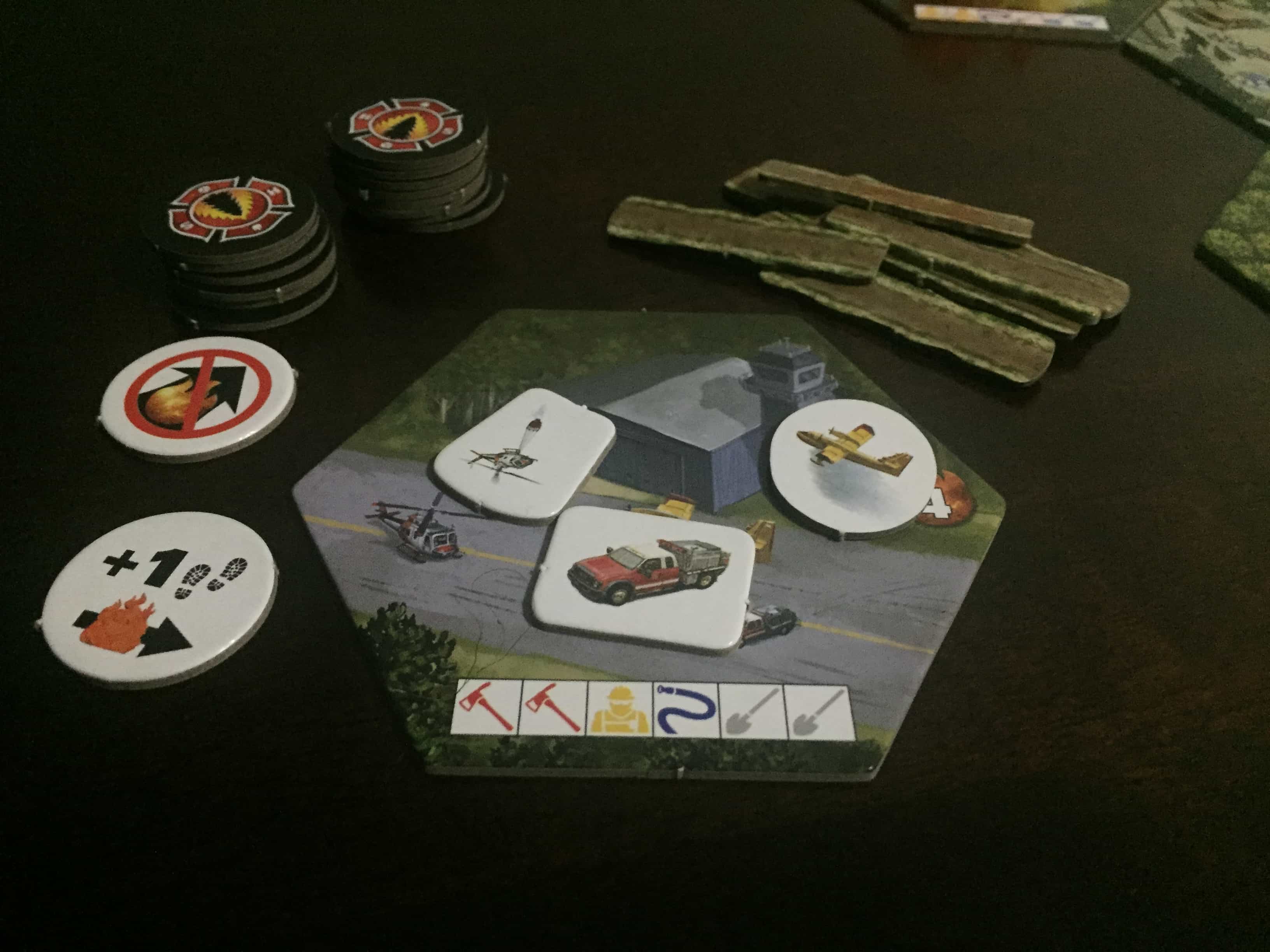
Could the addition of some longer term goals – saving campers or animals, for example – change up gameplay and bring in more of that tense, push-pull feeling? Perhaps a ‘forest animals’ expansion is in the works!
That’s my main complaint about Hotshots; I have two other minor ones. First, I felt that the Spotter role (who gets to peek at the event deck every round) had a bit too much of the spotlight. His power created the most interesting tactical decisions in the game. If he saw some nasty cards come up, or some changes in wind, he was able to shout that out and inspire some changes in plans. Two of the other roles – whose powers are to count two faces of the die as one another – are much, much simpler. I felt very strongly that Hotshots wants adults to play the Spotter and Crew Boss, while the kids play the other roles. That’s great for families, but didn’t go over so well among gamers of equal capacity.
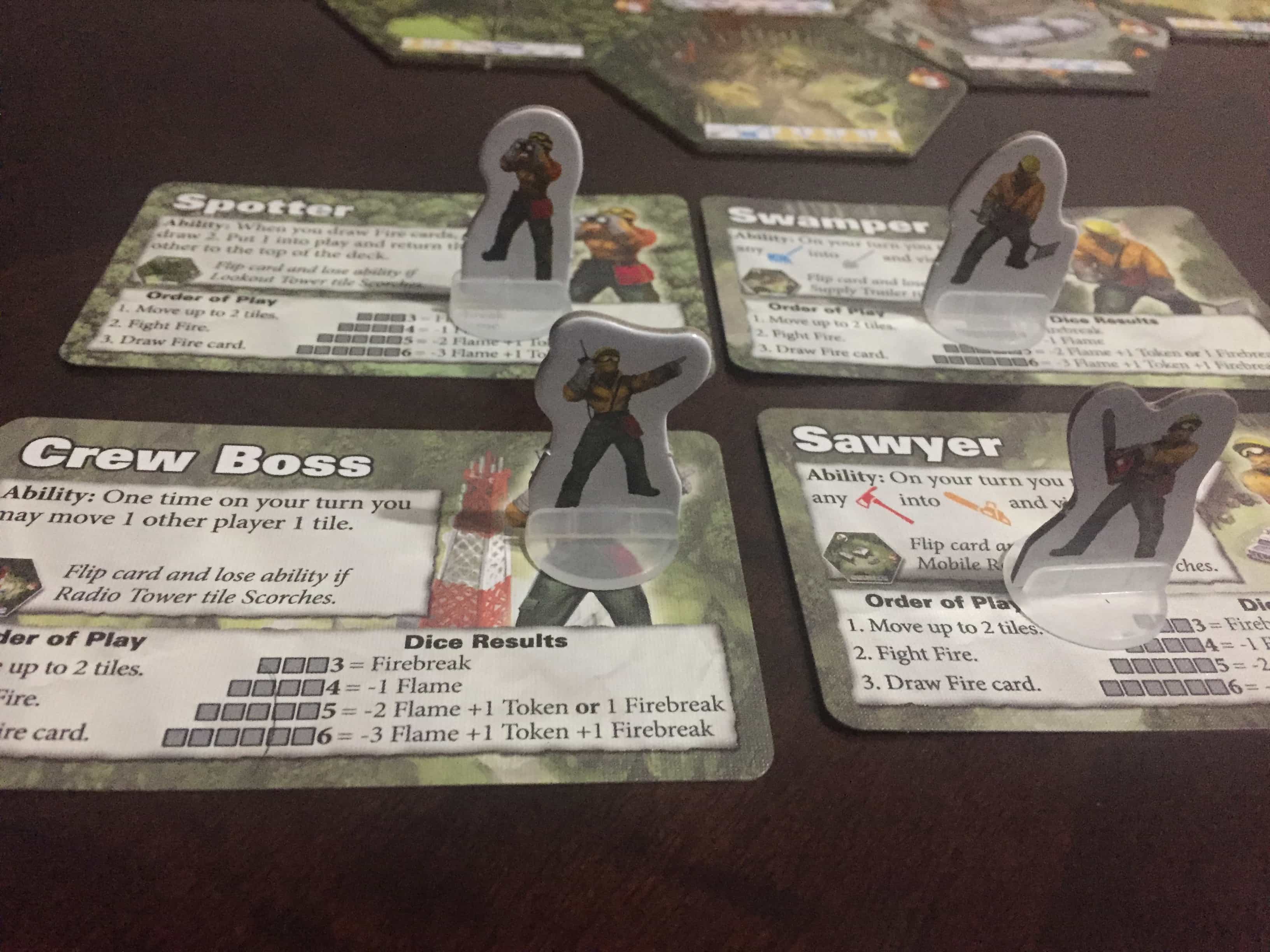
(The Spotter, btw, is also completely overpowered in one and two player mode because he allows you to see every event before it happens).
My other minor complaint is that victory might occur via chain scorches, which feels slightly unsatisfying. In one game, we had the fire contained to one side of the board. We realized that we could let all of those tiles burn to hell (remember, burned out tiles don’t catch fire), then just put out the little baby fire that was left in order to win. Some of my friends found that fun. Maybe that happens in real life more often than I think. It still seemed like kind of a heartless and/ or “gamery” way to end the game.
Final Verdict – Who is Hotshots For?
Like Castle Panic and, in a lesser way, Flash Point, I think Hotshots could use some expansions to liven up the gameplay and break some of the repetitiveness of the turns. However, on the whole, I enjoyed it! I think it manages to pack some good tactical decisions and tense moments into a very simple, family-friendly package. Fans of lighter weight cooperative games, or of the theme, might be very happy to pick this one up.


